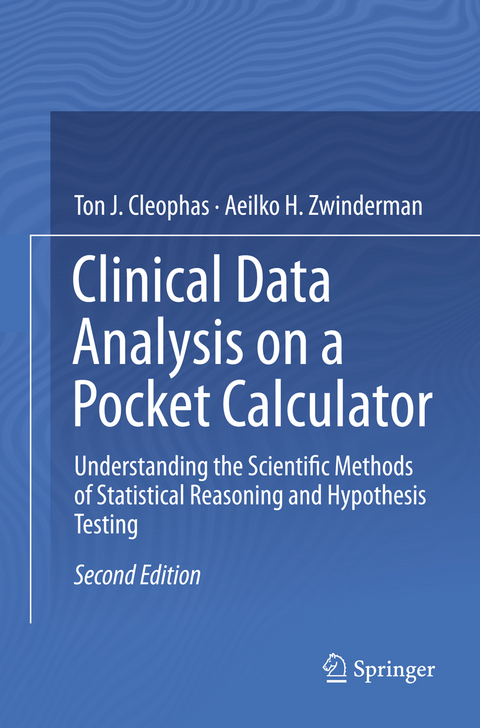
Clinical Data Analysis on a Pocket Calculator
Springer International Publishing (Verlag)
978-3-319-80074-5 (ISBN)
Inmedical and health care the scientific method is little used, and statisticalsoftware programs are experienced as black box programs producing lots ofp-values, but little answers to scientific questions. The pocket calculatoranalyses appears to be, particularly, appreciated, because they enable medicaland health professionals and students for the first time to understand thescientific methods of statistical reasoning and hypothesis testing. So much so,that it can start something like a new dimension in their professional world. Inaddition, anumber of statistical methods like power calculations and required sample sizecalculations can be performed more easily on a pocket calculator, than using asoftware program. Also, there are some specific advantages of thepocket calculator method. You better understand what you are doing. The pocketcalculator works faster, because far less steps have to be taken, averages canbe used. The current nonmathematical book is complementary to thenonmathematical "SPSS for Starters and 2nd Levelers" (Springer HeidelbergGermany 2015, from the same authors), and can very well be used as its dailycompanion.
The authors are well-qualified in their field. Professor Zwinderman is past-president of the International Society of Biostatistics (2012-2015), and Professor Cleophas is past-president of the American College of Angiology (2000-2002). From their expertise they should be able to make adequate selections of modern methods for clinical data analysis for the benefit of physicians, students, and investigators. The authors have been working and publishing together for 17 years, and their research can be characterized as a continued effort to demonstrate that clinical data analysis is not mathematics but rather a discipline at the interface of biology and mathematics. The authors as professors and teachers in statistics at universities in The Netherlands and France for the most part of their lives, are convinced that the scientific method of statistical reasoning and hypothesis testing is little used by physicians and other health workers, and they hope that the current production will help them find the appropriate ways for answering their scientific questions. Three textbooks complementary to the current production and written by the same authors are Statistics applied to clinical studies 5th edition, 2012, Machine learning in medicine a complete overview, 2015, SPSS for starters and 2nd levelers, 2015, all of them edited by Springer Heidelberg Germany.
Preface.-I Continuous Outcome Data.- Data Spread, Standard Deviations.- Data Summaries:Histograms, Wide and Narrow Gaussian Curves.- Null-Hypothesis Testing withGraphs.- Null-Hypothesis Testing with the T-table.- One-Sample Continuous Data (One-SampleT-Test, One-Sample Wilcoxon.- Paired Continuous Data (Paired T-Test, Two-SampleWilcoxon Signed Rank Test).- Unpaired Continuous Data (Unpaired T-Test,Mann-Whitney).- Linear Regression (Regression Coefficients, CorrelationCoefficients, and their StandardErrors).- Kendall-Tau Regressionfor Ordinal Data.- Paired Continuous Data, Analysis with Help of CorrelationCoefficients.- Power Equations.- Sample Size Calculations.- ConfidenceIntervals.- Equivalence Testing instead of Null-Hypothesis Testing.- NoninferiorityTesting instead of Null-Hypothesis Testing.- Superiority Testing instead ofNull-Hypothesis Testing.- Missing Data Imputation.- Bonferroni Adjustments.- Unpaired Analysis of Variance(ANOVA).- Paired Analysis of Variance (ANOVA).-VariabilityAnalysis for One or Two Samples.- 22 Variability Analysis for Three or More Samples.-Confounding.- Propensity Score and Propensity Score Matching for MultipleConfounders.- Interaction.- Accuracy and Reliability Assessments.- Robust Testsfor Imperfect Data.- Non-linear Modeling on a Pocket Calculator.- FuzzyModeling for Imprecise and Incomplete Data.-Bhattacharya Modeling for Unmasking Hidden Gaussian Curves.- Item ResponseModeling instead of Classical Linear Analysis of Questionnaires.- Meta-Analysis.- Goodness of Fit Tests for Identifying Nonnormal Data.-Non-Parametric Tests for Three or More Samples (Friedman and Kruskal-Wallis).- IIBinary Outcome Data.-Data Spread: StandardDeviation, One Sample Z- Test, One Sample Binomial Test.- Z-Tests.- Phi Testsfor Nominal Data.- 38 Chi-Square Tests.-Fisher Exact Tests Convenient for Small Samples.- Confounding.- Interaction.- Chi-squareTests for Large Cross-Tabs.- Logarithmic Transformations, a Great Help to StatisticalAnalyses .- Odds Ratios, a Short-Cut for AnalyzingCross-Tabs.- Log odds, the Basis of Logistic Regression.- Log Likelihood Ratio Testsfor the Best Precision.- Hierarchical Loglinear Models for Higher Order Cross-Tabs.- McNemar Tests for Paired Cross-Tabs.-McNemar Odds Ratios.- Power Equations.- Sample Size Calculations.- AccuracyAssessments.- Reliability Assessments.- Unmasking Fudged Data.- Markov Modelingfor Predictions outside the Range of Observations.- Binary Partitioning with CART (Classificationand Regression Tree) Methods.- Meta-Analysis.- Physicians' Daily Life and theScientific Method.- Incident Analysis and the Scientific Method.- Cochran Testsfor Large Paired Cross-Tabs.-Index.
| Erscheinungsdatum | 18.06.2018 |
|---|---|
| Zusatzinfo | XXIII, 334 p. 65 illus., 24 illus. in color. |
| Verlagsort | Cham |
| Sprache | englisch |
| Maße | 155 x 235 mm |
| Gewicht | 551 g |
| Themenwelt | Medizin / Pharmazie ► Pflege |
| Studium ► Querschnittsbereiche ► Epidemiologie / Med. Biometrie | |
| Naturwissenschaften ► Biologie ► Zoologie | |
| Schlagworte | Clinical data analysis • Entomology • Health Care • Medicine • statistical analyses • statistical software analysis |
| ISBN-10 | 3-319-80074-4 / 3319800744 |
| ISBN-13 | 978-3-319-80074-5 / 9783319800745 |
| Zustand | Neuware |
| Haben Sie eine Frage zum Produkt? |
aus dem Bereich


